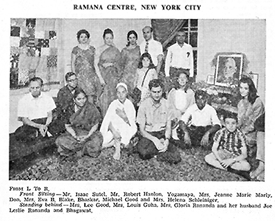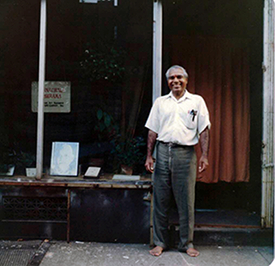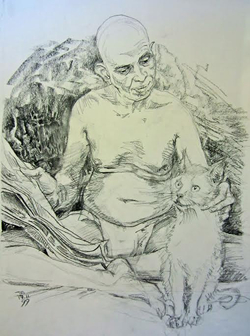50th Anniversary of Arunachala Ashrama
A Center for Daily Practice is Established in New York City
Part III
On December 8th, 1966, in New York City, for the purpose of incorporating a Bhagavan Sri Ramana Maharshi Center pursuant to Article 10 of the Religious Corporation Law, Arunachala Ashrama was incorporated in the State of New York. Article XVIII of the By-Laws reads: “The purpose of the Center shall be to provide an educational and spiritual center for the study, pursuit and practice of the spiritual heritage bequeathed to mankind by the Great Sage Bhagavan Sri Ramana Maharshi.”
THE first rented space for Arunachala Ashrama was in the East Village of Manhattan at 78 St. Marks Place, near First Avenue. It was just an upstairs room in an apartment building. That is when Arunachala Bhakta Bhagawat started his daily routine of taking the F Train subway from Brooklyn to Manhattan to open the Ashram. In the evening devotees would come for the nightly chanting, meditation and reading of Bhagavan’s teachings. A simple meal, usually of rice, dhal and potatoes, cooked by Bhagawat himself, would be served after the practice. He would spread a mat on the floor and all would eat sitting around it. Bhagawat always ate like the simple villager he was, with his hands.
“Openness of Heart,” was a favorite expression of his. “Guilessness and humility,” he would say are the essential qualities of a true aspirant. And he longed for such rare, pure souls who embodied these qualities. “One must have an open heart for God to enter, and if it remains closed, even among friends, how can you realize the Self or God?”, he would often ask. Bhagawat would travel any distance at any time of the day or night to benefit from serving and associating with such friends. “I need your company more than you need mine,” he would tell us. And he believed it, though we certainly thought otherwise.
Arunachala Bhakta Bhagawat provided us the living example of how to gain Bhagavan’s grace and attain the purpose of human existence in light of the life and teachings of Sri Ramana Maharshi.
Although Bhagawat was such an intelligent man, we really never saw him use his intellect or direct his self-will in making decisions in his life. Inspiration and intuition were the forces that motivated him. And he believed it all came from “Arunachala Siva Bhagavan Sri Ramana Maharshi” Himself. During this period of the Ashrama history, he wrote in his prayer manuscript: “I wander about like a drunken person who does not care what the world thinks of him, as he is oblivious to the physical world in his inebriated state.”
He placed whomever came to the Ashrama on His head, metaphorically, and gave the person full attention, respect and devotion. But if it turned out that people came to deceive, disturb or exploit, he would not hesitate to confront them. He was vigilant to protect the Ashram and its devotees from negative and misguided people. He instilled in all who kept company with him the importance of loving kindness, service, respect and devotion to the ideal manifested in all creation.
In 1969 the Ashram moved to a rented storefront at 342 East 6th Street in Manhattan, just two blocks south of the first location. This remained the Ashram’s home for the next 18 years. It was here that I (the editor) first arrived in Bhagavan’s American abode in November of 1971. Already earlier this same year Joan and Matthew Greenblatt and Evelyn Kaselow had become attached to Bhagavan and the Ashrama that Bhagawat had founded. When I first met Bhagawat I asked him if he was the teacher here and he said, pointing to Bhagavan’s photo on the altar, “He is – that old man. He is the teacher and we practice the teachings.”
“Do you preach,” I asked. “He said, “Yes, we preach, but with the ‘p’ removed from the word preach, that is, we ‘REACH’!”
“Then what do you do here?” I asked.
“You see the entrance door there? Do you see the doormat in front of the door? Bhagavan has made me his doorman and doormat, the servant and servitor in His Ashram.” He always referred to the Ashram as Bhagavan’s Ashram only. And that same day he went on to describe Arunachala Ashrama as “AAA: Arunachala Abhyasa Ashrama.” The Ashrama is a place to ‘practice’ the teachings, not for discourses and discussions. He always emphasized the necessity of daily, regular practice of Bhagavan’s teachings. Bhagavan has said that those who have succeeded owe their success to perseverance. Bhagawat would tell visitors, “We believe in hard work.” Most visitors did not. They wanted some quick and easy way to Self-Realization. They would be told there are no quick shortcuts. Hard work, discipline, service, intense devotion perhaps over many years is required. Many visitors left when they heard this, hoping to find a guru who would give them mukti by a wave of the hand.
Much earlier Bhagavan had come to Bhagawat in a dream and explained to him the technique of abiding in the Heart. Describing this to us, Bhagawat would tell us,
Watch wherefrom the sound arises: it is the Heart.
Watch wherefrom the I arises. It is the Heart.”
Bhakta Bhagawat followed in the tradition of a householder, a married person, yet he was totally devoted to his Master and Lord, Bhagavan Ramana. He provided a touching example of how this can be harmonized. He had a very simple village wife and one son. His love and attention extended to the devotees and to them equally. He made all feel as members of one family. Bhagawat could never fulfill his wife’s wish to own a house and other material possessions common in the West. He had no desire for these things himself but felt much compassion for her because of this. In her last years, when she had gone blind, I overheard a visitor ask Bhagawat what he did in the Ashram. “I serve Mother,” was his simple reply. I doubt whether the visitor understood what he was talking about, but I knew.
As for his son, Bhagawat gave him complete freedom. He believed example was the best form of guidance, and that is what he provided. He once remarked, “In my Indian tradition it is said that once a son reaches 16 years of age he then becomes your brother.” If asked by his son, he would always advise him properly. And he took him to India to marry. Bhagwat continued to shower love and affection on him, his devoted wife and wonderful children, whom he named. Yet, I never heard him say “my son,” but always “our son” when referring to him. The innocent charm and devotion of his grandchildren gave Bhagawat much happiness. He was always their Baba and they loved him dearly. And we looked upon them as our children too. They are your family to whom your hearts unite in love and friendship. We all felt like one family totally protected and guided under the watchful eye of our Master and Lord, Bhagavan Sri Ramana.
The Cat on Bhagavan’s Couch
The following is taken from the book Ti-Puss written by Ella Maillart of Switzerland and published in 1951. She sent the copy found in Sri Ramanasramam’s library to Swami Viswanatha with the inscription: “For you, Viswanatha, so that you may sometimes remember your friend, the Daughter of the Mountains.”
ELLA Maillart was an early 20th Century pioneer among women adventurers. Strong, ever curious about the unknown and fascinated with travel she sailed over seas and journeyed with caravans, on foot and seated on animals, throughout remote areas of Chinese Turkestan, the Caucasus, the Tien Shan Mountains, Russia, Mongolia, Tibet, etc. She realized that the only way for her to make a living was to write about her experiences. During World War II she remained in India from 1939 to 1944 and resided mostly in Tiruvannamalai, understanding, at last, that the ultimate adventure and real journey is to make the inner one to the realization of the Self.
Ti-Puss appears on the surface to be a frivolous book about Ella’s infatuation with a kitten. But in the book one finds hints here and there about her inner experience and understanding of all things that she absorbed while living in the presence of Bhagavan Ramana. Ella wrote: “ The teaching says: ‘It is for the sake of the Self that all things are dear,’ though we usually think it is for the sake of the loved object. This cat, so alive in me that she has become like part of me, opened my heart where love was dormant... ‘Love being the real Self.’ When my feeling of love becomes uppermost for an extremely short while, there is neither cat nor any limited individuality. I am lost in love-impersonal, love which is a state where time has no power.”
After the war and her return to Switzerland, Ella settled into a villa which she named Achala, in one of the highest villages in the Swiss Alps. She would occasionally arrange cultural tour groups to Asia. To her travel companions she would often say: “Ask yourself unceasingly, ‘Who am I?’ and through this constant inquiry you will come to know that you are the Light of Consciousness.”
For devotees who are cat lovers and have been uncertain about the Sage’s opinion of these four-legged denizens of the dark, read on and take heart. Bhagavan’s love embraces all. Ella writes:
In the neighborhood of the Ashram, I was fond of three different walks – the mountain, the lagoon and especially the grove of Palakothu adjoining the garden of the Sage where the sadhus lived in their miniature huts. Every afternoon, loudly and endearingly, the cat insisted on my taking her for an outing, galloping off excitedly and then returning to me! I think she greatly enjoyed our hide-and-seek promenades and her slight fear when we discovered new paths.
But, honor to whom honor is due, the cat called on the Sage! One early morning I found her near me as I was leaving my sandals by the door before entering the hall. She must have crossed the road behind me, and passing among the tombs of holy men, followed me by the old tank with the many stone steps leading to the water-level. I let her do what she wanted. As I greeted the Maharshi by joining hands, my cock-sure Ti-Puss jumped on the couch where the Sage spends all his time. Particularly kind to animals, feeding the squirrels, peacocks and monkeys coming to him, as well as Lakshmi the oldest cow of the ashram who was fond of bananas, the surprised Maharshi put his newspaper aside, smiled at the thin kitten and touched her head. I am sure she would have played with him, because all animals behaved with him as if he ‘belonged’ to them; but the fussy Brahmins sitting near the couch frightened her away with their shawls, though they heard my saying: “This is my faithful companion, back from bathing in the Ganges!”
From a bold charmer, tail upright and full of good intentions, she became a hateful mass of cringy fur.
“Why do you do that?” I asked the men.
“Because it will run after the squirrels and kill them!” As usual the Maharshi was not interested in the variance of opinions around him. His concern was to give answers, in Tamiḷ and Telugu, seldom in English, to the philosophical questions put to him by visitors, or sometimes to correct the Sanskrit recitation of a devotee.
An hour later when the inmates received their mail from Rajah the Postmaster, my share included the first copy of Cruises & Caravans which I had dedicated to the Maharshi. I then presented that copy to him, feeling suddenly ashamed to have written that story very perfunctorily.
The dust-cover showed the house of my childhood by our lake, with many racing yachts at their moorings with sails hoisted. [Ella Maillart had represented Switzerland in sail boating in the Olympics when young. She was also a world-class skier.] When the long and elegant fingers of the Sage framed that beloved bay which had cradled my dreams, I saw that the dreams of those days had led me very slowly to the feet of his all–embracing knowledge.
When Viswanatha, the young sadhu who was my friend, came in, “Have you seen Ella’s book?”, the Maharshi said, handing it over to him. The sage seemed pleased: when he looked at me directly but with his ‘impersonal’ stare, once again I thought that I had never seen a forehead with equal width, light and refinement....67th Mahanirvana of Sri Ramana Maharshi
You, your family and friends are cordially invited to join us in observing
the 67th Aradhana of Sri Ramana Maharshi
Fremont Senior Center
40086 Paseo Padre Pkwy
Fremont, CA 94538
Tel: 510.656.2752
Saturday 15 April – 11:00am
Bhagavan Sri Ramana Maharshi Ctr
86-06 Edgerton Boulevard
Jamaica Estates, New York 11432i
Tel: 718.560.3196
Saturday 29 April – 11:00am
The programs will include parayanams, bhajans, talks and puja, followed by prasad.
Questions and Comments
Mind Control, Chanting and Diet
Hope you and all devotees are well there, in His Grace. Here we are enjoying the most beautiful weather, short days with no rain; it has been like that for a long time, and no heat.
I went back to reading the
Yoga Vasiṣṭha
and translating the parts that are deeper for my practice. This helps me to understand better. In one part Vasistha tells Rama that a master will not waste his time with a disciple who has not trained his mind (my own words). He states that this is the first requirement. This was the answer to my question: “Why do I see no progress?” Although now the question looks stupid, as I have been feeling a lack of motivation, or a lack of purpose, in a way. What’s your recommendation, if any?
I am trying to change the practice and go back to something I used to do, that is, chanting the morning Vedas everyday. However, I found out I don’t have the text. I only have a fragment of the evening Vedas. This practice helped me before to quieten the mind for meditation. It also was a sort of catalytic experience at one point. I can do this only in the mornings, and really hope you have the transliteration in a document. I also discovered that diet helps...the less I eat, the lighter the head.
Regards to devotees there.A Florida Devotee
It is true that all the scriptures and Mahatmas say we need to control the mind before realization can be achieved. A controlled mind means a mind freed from raga and dvesha, likes and dislikes. To control the mind intense vairagya is necessary, otherwise the mind will always be going outwards towards trifling sensual or intellectual pleasures. And to control the mind we need abhyasa, regular spiritual practice. There is no other way. At some point we will find that the spiritual practice becomes all-consuming and nothing else interests us. Then the goal is at hand.
The Bhagavad Gita teaches the importance of vairagya and abhyasa and Bhagavan emphasized the same thing. Very, very few are like Mastan Swami. Bhagavan simply gave him his glance of grace and Mastan became absorbed in Him – liberated. People like us have to plod on with determination and resolve. Bhagavan said that the few who have succeeded owe their success to perseverance. We should strive to be that ‘few’.
About diet, it is true: “Sattvic food in moderation,” said Bhagavan. Many also experience the benefits of this discipline, but we should not undereat and thus weaken our constitution. Concerning the transliteration of the Morning Veda Parayana, please go to the following web page: /docs/veda-parayana
Click the above and you will find links to the morning and evening transliterations of the Vedic chanting from Sri Ramanasramam. Since many devotees have asked, we plan to scan The Veda Parayana book and make a PDF of it . This will provide the English translation. We will make it available at this site too. It has been out of print for many years.






Purpose of the Practice
My questions are about the purpose of spiritual practice? What direction should we have in our mind? I understand that we meditate to quiet our minds and realize our true nature, our ‘I-Am’ essence. Through this practice we want to attain enlightenment, freedom, or whatever we call it. Will this practice also liberate the consciousness trapped in this reality? What should be my practice?
I have been exploring Kabbalah and have felt that the practice of Kabbalah really helps, but I want to meditate on a deeper level. In Kabbalist meditation it takes but an instant to connect, but I feel it should be longer, deeper and less intellectual.
Please, guide me through this process. I am trying to make sense of all the practices I have pursued and make them more productive and efficient.
Another Florida Seeker
Thank you for writing. I did not get a chance to call you before leaving, and it may be just as well since the exercise of writing down your thoughts and questions may have helped you better articulate exactly what you wanted to ask.
First of all, you asked, “What is the purpose of the practice?” Then you answered this question, “I understand we meditate to attain enlightenment or freedom.” Then you asked, “Will this practice also liberate the consciousness trapped in this reality?”
Bhagavan Ramana’s teachings make it clear that the purpose of the practice is to know who we are. In the waking state, we believe we are this body; in the dream state, we create another body and believe we are that body when in the dream. The dream body negates the reality of the waking-state body and the waking-state body negates the reality of the dream body.
But then we fall into deep sleep. What happens then? We experience neither the waking nor the dream bodies and yet we exist without any awareness of a body. This is everyone’s daily experience, but no one thinks deeply about it.
So the purpose of the practice is to realize who we really are. Are we these bodies or are we the consciousnessawareness underlying the bodies? The bodies continually change, age and perish, but does the consciousness underlying these three states change? And what is this consciousness?
Bhagavan has said that the whole dilemma of existence and bondage to the chain of successive births and deaths is caused by the erroneous belief that we are these physical bodies. And as long as we cling to this belief we will continue to suffer and be prevented from experiencing the joy of the ever-present, pure existence that is our true nature.
What is the practice? You want to experience the ‘real you’ as pure consciousness. To do this you have to detach yourself from the limited, erroneous, evanescent you, as a body. How to do this? You must focus on that point from where the body consciousness arises. That is the simple I-awareness. First the I-awareness rises, then comes body-awareness. Hold on to that conscious Iawareness and do not allow your thoughts to wander. Every time they do ask yourself, “Who am I?”
Unless the mind is somewhat still to begin with you cannot easily hold onto this I-awareness. So, first sit quietly and calmly, watch the in-going and out-going of the breath. Do not try to control it. Just watch it go in and out, one-pointedly. After some time you will find the breath becoming more and more subtle or still. When the breath becomes still, the mind becomes quiet automatically.
Once your mind becomes quiet then seek from where the I-awareness issues forth. Steadily and onepointedly seek from where within you the I-consciousness arises. This is the practice. But there are ways in our daily life to aid us in this practice.
First of all, when you are at work, do your job with one-pointed attention to the best of your ability. When you leave work, the work should also leave your mind. Do not take it with you. You need to do it with onepointed attention and at the same time total detachment. Believe that you are just an instrument, not the doer. Bhagavan has said that the work that has been preordained for this body will have to be performed: so, perform it with detachment. The work is not you purpose in life. Your purpose is to realize your true nature.
When you are free from work, turn your mind to the inner quest. Whether by repeating mantras, reciting stotrams, chanting, study, etc., primarily keep the inner quest of “Who am I?” as your aim. You may not be able to keep up the enquiry all the time. At those times you can take to these other practices.
So this is the practice. It is the path given to us by Ramana Bhagavan. If you take to it in all earnestness he will extend his grace and make it fruitful. You can turn to him in times of difficulty and he will provide you with help and solutions. He is the inner Guru who is always present to lead you on to the realization of your true nature.
There is one more thing. It will not help to continually shift from one form of practice, from one guru to another, from one spiritual ideal to another. Take your time and choose which path suits you best, which gives you more peace, clarity and inspiration and then stick to that path.
I hope this covers the points made in your letter. A visit to Sri Ramanasramam in India, although not essential, will surely serve to provide added inspiration to establish you on this path. Think about it.






